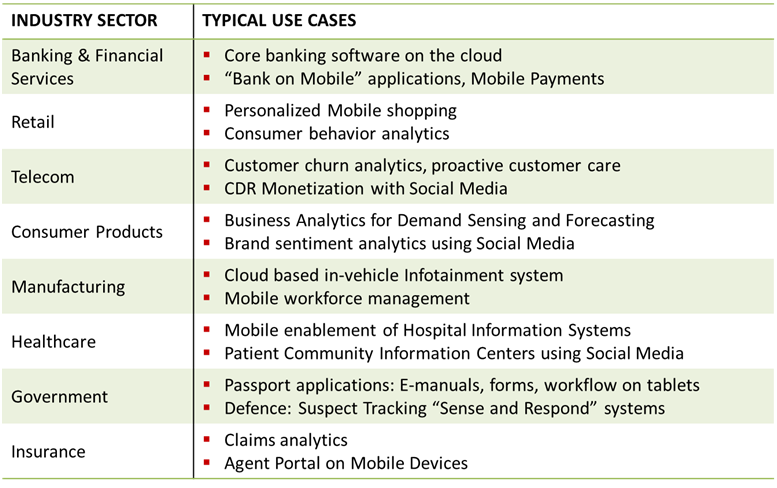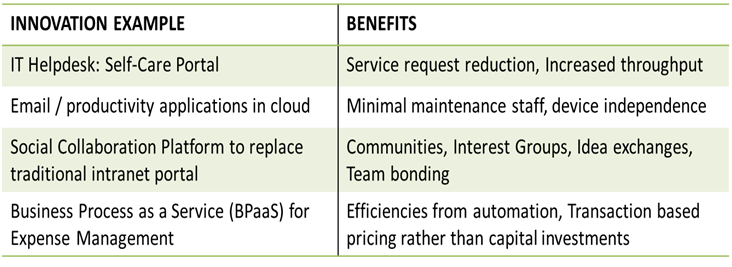In my previous post Innovation in Industry – An IT Services Perspective – Part 1 I wrote about the long-term challenges likely to be faced in the IT Services sector, and why innovation initiatives will be critical for survival and growth. This applies across the sector – both for large and established companies as well as smaller and younger companies.
Most companies, across industries, have recognized this and are putting in place the strategies, plans and execution mechanisms to address the same. The differences are in terms of scale, priorities, and the resulting speed of execution and implementation.
In the IT Services space, not surprisingly, the focus is more on innovation enabled by technology. One trend that we see today is that technology today is no longer just an efficiency enabler. Technology is now seen as fundamental to achieve three key business objectives: Collaboration, to maximize human capital; Customer relationships, through deep engagement; and Product Innovation, through emerging and disruptive technologies such as mobility, analytics, cloud and social media.
While innovation does not necessarily come through new technologies, the influence of emerging and disruptive technologies, or ‘digital disruptions’ on innovation initiatives cannot be underestimated. Some interesting data points are:
- By 2016, the number of mobile devices is likely to outnumber the human beings on the planet
- Cloud adoption is beyond the tipping point – the benefits of resource optimization, agility and cash flow management just cannot be ignored any longer
- Data warehousing and reporting is not enough – the need today is to draw meaningful insights from information available via business analytics
- Social Media is likely to become a primary means of customer communication over the next 5 years
What are some examples of such “digital disruptions” across industry sectors? The table below illustrates some typical use cases.
For such use cases involving innovation initiatives enabled through digital disruptive technologies, it is the IT organization (the CIO team) who invariably has to execute and implement.
Closer home, given below are some examples from the Happiest Minds CIO team.
Darshan Appayanna, the CIO of Happiest Minds, gives this example. “The cloud productivity and collaboration platform that we use has enabled us to scale rapidly and support with a very lean IT team (2 FTEs) to support 1200 people. Along with this brought customer satisfaction as employees were able to access these services from anywhere on any device greatly improving productivity and collaboration.”
Rajesh R Kumar, Enterprise Architect, gives an example of an in-house cloud based integration platform called Sparks Hub. “Integrating enterprise applications of varied technologies has always been associated with establishing fairly complex integration infrastructure such as an ESB and maintaining numerous services exposed by various systems. How about having an integration infrastructure that is practically invisible (say deployed in some cloud server) and has literally zero configuration and setup required to use the infrastructure? That is precisely what Sparks Hub provides. Sparks Hub brings in a new integration paradigm that works based on simple exchange of Resources (read as ‘Data’) across Enterprise system irrespective of the technology stack of the systems. Today Sparks Hub integrates numerous systems across Happiest Minds that enables us to achieve integration in matter of days.”
In summary: Innovation in industry is happening across sectors whether retail, manufacturing, consumer goods, financial services, healthcare, government, and so on. Digital disruptive technologies are accelerating the push towards technology innovation. The IT sector is in the thick of the action and increasingly involved in innovation initiatives across these sectors. For the IT Services sector to survive and thrive, an innovation focus appears to be increasingly critical. At the end of the day, it is this focus that will help IT services companies to help their customers to innovate – and transform business.

Shantanu is a former Happiest Mind and this content was created and published during his tenure.








